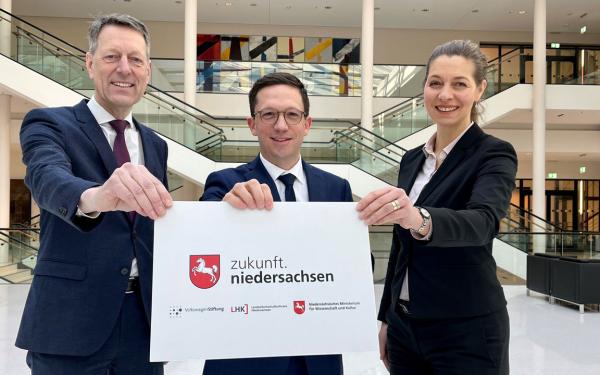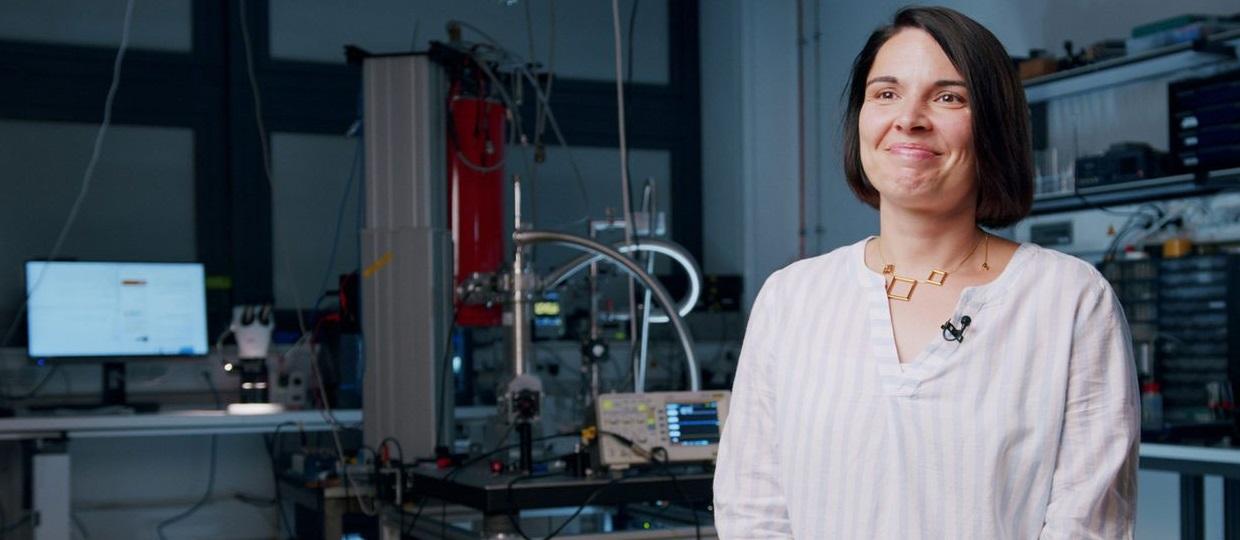
Element K für VolkswagenStiftung
Quantum technology: Computing with light
Stefanie Kroker works in the field of nanometrology, creating the tiniest structures and developing techniques to measure them as precisely as possible. Research on quantum computing could also benefit from this. A portrait.
If you place several burning candles next to each other in a row, an impressive phenomenon occurs: their flickering synchronizes. Whenever one of the flames grows larger, that of the next candle shrinks in the same rhythm. If one arranges the candles differently or changes the spacing, different patterns can be created at will. "This came as a great surprise to me. I hadn't been aware of it before," Stefanie Kroker says, adding with a laugh, "…even though I've been studying physics for a very long time."
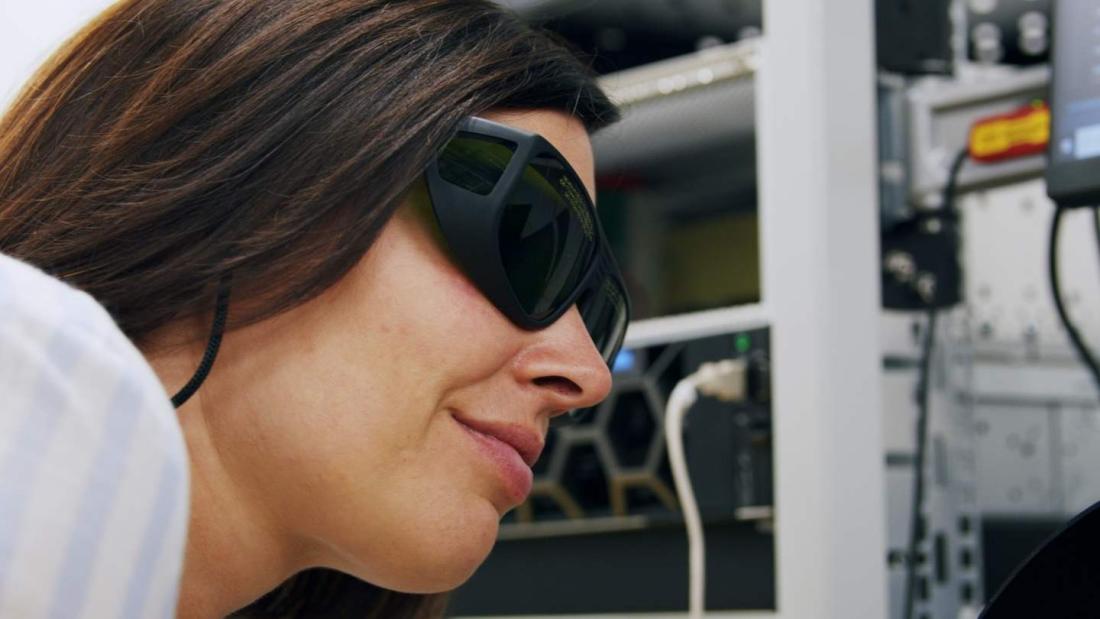
Element K für VolkswagenStiftung
Kroker is a professor of physics with a main focus on nanometrology at the TU Braunschweig. A video portrait of Stefanie Kroker.
Kroker is a professor of physics with a main focus on nanometrology at the TU Braunschweig. Her work involves investigating how light can be used to generate certain states at the atomic level in a finely targeted manner and then to measure them with a high level of precision. She came across the phenomenon of synchronized candles at last year's round of "Jugend forscht", a science competition for young people under the age of twenty-one of which she has been a member of the jury since 2021. It was presented by two high-school students from Munich and Heidelberg, who also provided the corresponding equations to describe the phenomenon precisely and even simulate it on the computer.
Calculating what happens in nature
Using mathematical formulas to make the world around us more tangible serves as a source of inspiration not only for young researchers: It is also what attracted professor Kroker to physics. Already as an infant, she enjoyed working with numbers – and she could do math before she learned to write. Things got really exciting for her in the lower secondary, when physics classes were added to the curriculum. She came to realize that juggling with numbers does not have to remain an end in itself. "Something happens in nature and you can describe it in mathematical terms: In other words, you can calculate it. I found that totally awesome."
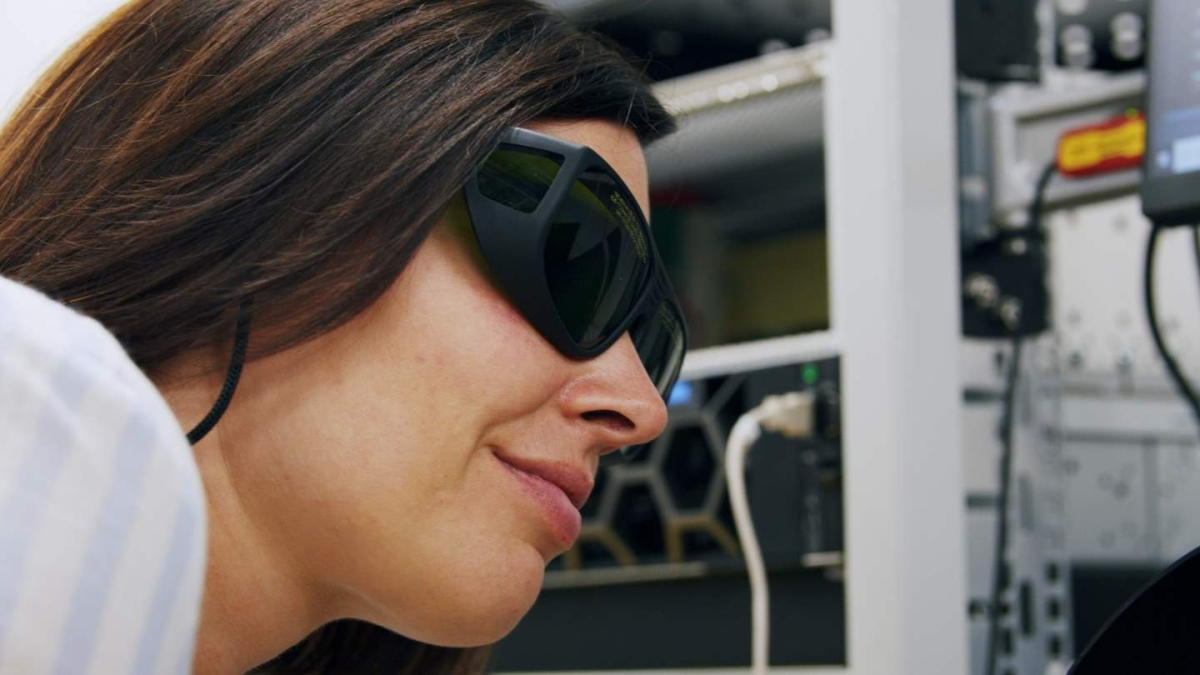
Stefanie Kroker in her laboratory. When working with the optical devices, protective glasses that darken are required.
Stefanie Kroker deepend her interest in science, and she chooses mathematics and physics as her advanced courses for high-school graduation – with such success that she is sponsored by the Studienstiftung des deutschen Volkes (German National Academic Foundation) when she leaves school. She goes on to study physics at the University of Jena. Yet, she would not describe herself as a typical math physics nerd. "It's not that I don’t have other interests," she says. For many years, Kroker played various musical instruments, even toying with the idea of pursuing a career as a musician. In the end, though, this remained a hobby. Which, she says with a smile, is also because she is not a night person at all. "Being on stage every other night – that’s not for me."
Accessing atoms
Later, while still a student at university, her aversion to working at night also played a not insignificant role in another career decision. "When it came to deciding on a thematic focus, I was quickly able to exclude astronomy". But in any case, even without the mandatory night shifts at the observatory, theoretical physics would have been simply too abstract for her. "I always wanted my research to be as application-oriented as possible", she says. For her Diplom, she chose the field of solid-state physics. "That's where things really get hands-on, where material samples first have to be produced before being described and characterized mathematically." And when it comes to minute structures, light plays an important role as a measuring instrument – something that also involves the physics subfield of optics.
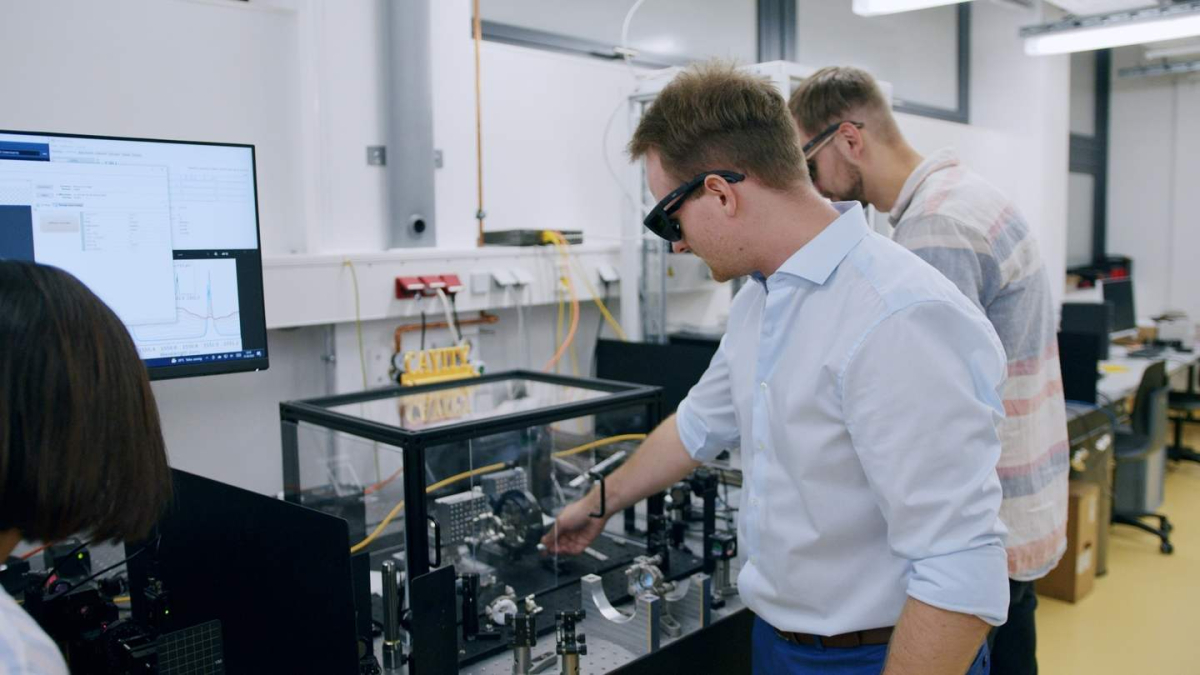
Stefanie Kroker and her team discuss an experimental setup.
For her doctorate, she then switches entirely to optics. As member of a research group for microstructure technology at the University of Jena, she is doing research on light-matter interactions on structured surfaces. "It's about designing optical materials in such a way that the light they emanate can be changed in a targeted way." When these light states then interact with matter, they are altered in characteristic ways. "This is something you can measure," Kroker explains. In such a process, lasers with ever shorter wavelengths make it possible to image a range of just a few nanometers. "At the same time, it becomes possible to access specific excitation processes in atoms, molecules and cells." Creating a defined state and then measuring it,. "One requires the other – and it only works in tandem," Kroker explains.
The computers of the future
This is particularly relevant for research on quantum computers, in which the TU Braunschweig is also involved as part of the Excellence Cluster "QuantumFrontiers" and the research network "Quantum Valley Lower Saxony" (QVLS). The network is funded by the Volkswagen Foundation under its funding program "zukunft.niedersachsen". In theory, such devices can revolutionize classical computing. Instead of only computing with the states 0 and 1, a quantum computer can also compute with the states in between by means of so-called qubits. Such a qubit can not only assume either the state 0 or the state 1, but also both states simultaneously.
This makes it possible to process many different states in parallel and thus solve highly complex combinatorial problems – in the area of logistics, for example. "Suppose you wanted to use a classical computer to calculate the route a delivery vehicle would take between 30 addresses. To choose the shortest route, the machine would need about as long as the lifetime of the universe," Kroker explains. "For a quantum computer, on the other hand, such a task is quite manageable." Another fascinating field of application is medical research. "Such a computer would be able to simulate all the states of atoms and assemble completely new molecules, and thus active substances."
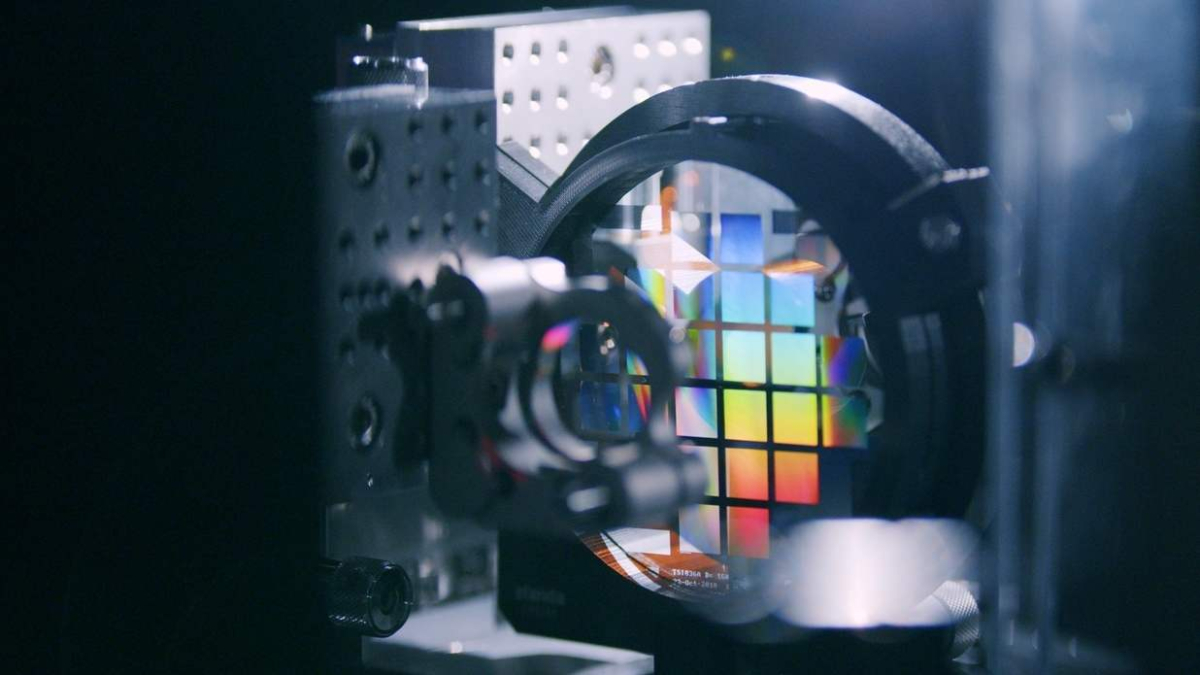
Detail shot of the optical apparatus. In the future, the complex optical structures should be the size of a computer chip.
Ions in the trap
So much for the theory. In practice, however, quantum computers are anything but easy to realize. The corresponding hardware, in which the qubits can develop their full computing power, has yet to be developed. The challenge is, among other things, to generate qubits in the first place, then to keep them as stable as possible during the computational process in order to be able to read off a result at the end. This is made possible by means of complex, but as yet not very practical optical setups. "Here, we're talking about thick steel plates, one by two meters in size, peppered with hundreds of small mirrors and components placed close together across the entire surface at intervals of two and a half centimeters," Kroker says. Such an apparatus has a future only if we manage to compress it to the size of a chip."
This is precisely what Kroker and her team in Braunschweig are working on. The qubits are ions, i.e., electrically charged atoms. These are fixed in electro-magnetic fields, so-called ion traps. "You can imagine it like a surface covered with lots of troughs," the physicist explains. In practical operation, she says, it is then important to be able to push the individual ions from trough to trough. "In some regions you might want to perform quantum operations, in others you might just want to store information." All of this should be possible on a chip in the future.
50 qubits by 2025
How much power a quantum computer can actually develop also depends on the number of its qubits. In the QVLS, the goal is to realize a system with 50 qubits based on ion-trap technology within the next two years. Is that realistic? Kroker is confident. "We have a very good chance – thanks to the superb expertise of the groups involved, the excellent collaborative research, and the outstanding infrastructure at the participating research centers," she says.
However, magnetically "trapped" ions are not the only promising candidates for qubits. These could also be realized by electrical currents flowing without resistance through superconducting circuits. This would allow quantum states to be processed particularly quickly. Ion qubits, on the other hand, can retain quantum properties over a longer period of time. "Which approach will ultimately be the winner is not yet clear," Kroker said. "It is possible that we will see combinations of different systems."
Workshops in schools
In addition to her research activities, teaching is also close to Kroker's heart. "I thoroughly enjoy lecturing," she emphasizes. "Being able to focus completely on the students is a wonderful balance to my other duties. It makes me feel connected." But the scientist also seeks contact with young people outside of university, giving lectures to schoolchildren, in Germany and sometimes abroad. Just recently, she was a guest at a high school in Istanbul. A former colleague from Braunschweig had invited her. "We did a workshop on how the things students learn, especially in high school, are actually of use in current research." The reference to practice, the link to reality: Maybe the same things that motivated Stefanie Kroker to pursue a career as a researcher will also catch on with other young talents.
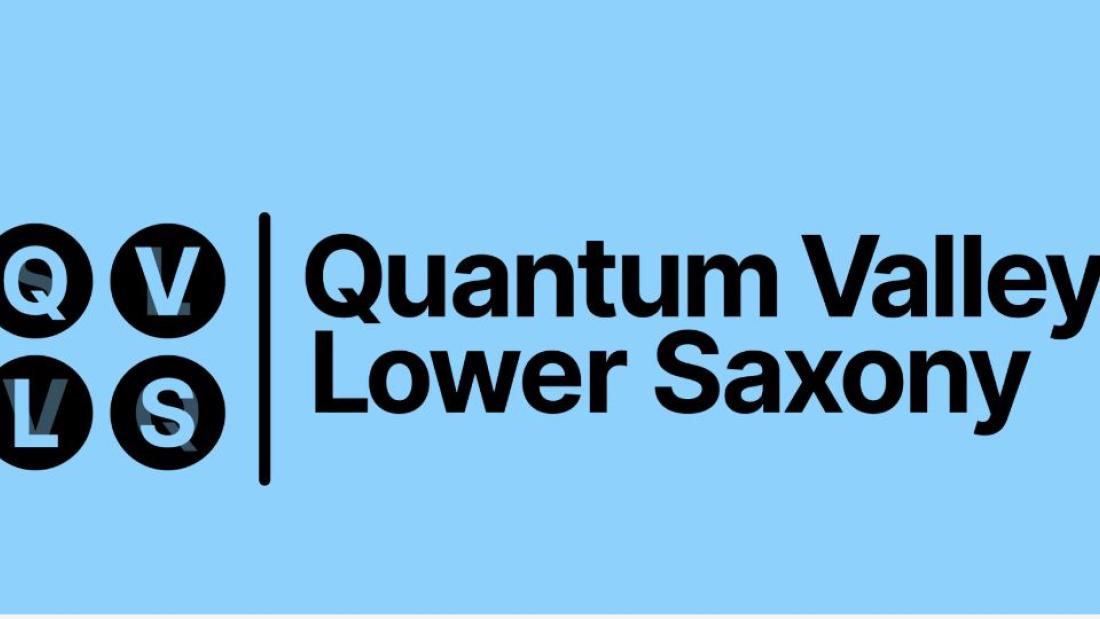
QVLS
In the video: The Quantum Valley Lower Saxony. The quantum computer from Lower Saxony.

